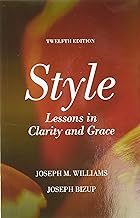Williams Helps Technical Writers Revise
Joseph M. Williams. 2003. Style: Ten Lessons in Clarity and Grace. New York: Longman.

Review by Stephen W. Hiemstra
In our shrinking world, it is easy to be misunderstood. Confusion can arise from being unlearned, uncultured, or untimely. Mix-ups can come from presumptions about gender, race or class; from lack of sleep, lack of tact, or lack of a sufficient coffee. But there is no excuse for being misunderstood because of a poorly chosen word! After all, the world is full of so many good stylebooks to choose from. (Or, is it—from which to choose?)
Joseph William’s book, Style: Ten Lessons in Clarity and Grace, stands out for his interest in complex sentences. The book aims at answering three general questions:
- What is it in a sentence that makes readers judge writing as they do?
- How can we diagnose our own prose to anticipate their judgments?
- How can we revise a sentence so that readers will think better of it? (ix)
Notice Williams’ focus on the reader: the mark of good writing is that it can be understood. Then, he goes on to focus not on writing, but on revision, where it is helpful to understand three distinctions between:
- grammatical terms like subject, verb, noun, active, passive, clause, preposition and coordination,
- topic and stress, and
- five unfamiliar terms: nominalization, metadiscourse, resumptive modifier, summative modifier, and free modifier (x).
Complex sentences are a particular problem in technical writing where the logical flow, balance, and structure can be daunting. This daunting nature arises because a complex sentence consists of an independent clause (a simple sentence) and one or more subordinate clauses (224), and highly technical subjects require a lot of complex sentences.
How do the roles of the different parts of the sentence relate to one another and how do multiple complex sentences hang together in mirroring the complexity of technical subjects without adding additional linguistic complexity? A paragraph composed of such complex sentences, though common in technical writing, has rules for managing this complexity that are not necessarily obvious, and are rarely discussed by most stylebook authors.
Williams starts by discussing clear, simple sentence construction and gradually adding complexity.
What does the reader expect, Williams asks? The answer is that in a fairy tale, the subject is a character and the action is a verb (34-39). The opposite of this clear structure is excessive use of nominalizations—verbs and adjectives masquerading as nouns (38)—which often move writing away from clear and active sentences. As complexity is added to the simple sentence, clarity is maintained by keeping subject and verb (and object) close together. If this prescription is followed, Williams argues, your sentences will be more concrete, concise, coherent, and clearer (46-47).
As Williams dives deeper into complexity, he defines a term that he refers to as metadiscourse, which refers to at least four things:
- the writer’s thinking and direction
- the writer’s degree of certainty
- directions to the reader
- logical connections in the writing itself (66)
While metadiscourse offers structure to a passage, the sentences themselves hang together (or not) depending on their own organization. Williams shows two ways this can happen: cohesion and coherence. Cohesion refers to “how each sentence ends and the next one begins” (78) while coherence refers to how well “all the sentences in a passage cumulatively begin” (79). Williams sees cohesion advanced by beginning a sentence with familiar points and words and ending with new or lengthy material (81). Coherence has more to do with “a sense of the whole” (83). Other authors may employ different words for these same two concepts.
Williams’ concept of cohesion naturally leads into a discussion of a complex sentence topic and stress. Topic has to do with the subject of the sentence, usually the front of the sentence, while stress (or emphasis) is usually articulated as the end of a sentence (99). The topic is familiar and links to the previous sentence while the stress is often new material. Being sensitive to these concepts not only enhances cohesion, but it also helps the author organize sentences around key points.
At this point, let me sum up.
Joseph Williams’ Style: Ten Lessons in Clarity and Grace targets experienced, technical nonfiction students and writers looking for a good stylebook. His stylebook is written in an accessible style and offers many examples of complex paragraphs written more concisely.

Author Stephen W. Hiemstra(MDiv, Ph.D.) is a slave of Christ, husband, father, author, and volunteer pastor. He lives in Centreville, Virginia with Maryam, his wife of more than thirty-five years. They have three grown children.
https://t2pneuma.com (Publisher site) https://t2pneuma.net (Blog)
